If you are looking for the best coldwater aquarium plants, then you are at the right place.
In this blog post, I will show you some aquarium plants that can tolerate cold water.
All the plants in this list are very undemanding, so even if you are a beginner you can easily keep them in your aquarium.
Table of Contents
Here’s a quick list of the best live aquarium plants for colwater aquarium.
- Guppy Grass
- Salvinia Natans
- Jungle Vallisneria
- Amazon Sword
- Ludwigia Repens
- Bacopa caroliniana
- Red Root Floater
- Subwassertang
- Java Moss
- Crystalwort
- Java Fern
- Brazilian Micro Sword
- Marsilea Hirsuta
- Pearlweed
- Anubias
- Hornwort
- Christmas Moss
- Cabomba
- Water Cabbage
- Brazilian Pennywort
- Creeping Primrose Willow
- Water Lettuce
- Madagascar Lace Plant
- Water Hyssop
- Pygmy Chain Sword
- Bacopa
- Hygrophila polysperma (aka Green Hygro)
- Sagittaria Subulata
Now, before diving deep into the list let me clear one thing.
I have included the plants that are generally good for cold water aquarium.
I have included some plants that can tolerate temperature as low as 50 degrees Fahrenheit and the plants that can tolerate temperature as low as 68-degree Fahrenheit.
So before keeping them in your aquarium, you should first know what is the temperature of the water of your aquarium or the ideal temperature for the fish in your aquarium (as different species of fish require certain water temperature to thrive) and then you can select any of the following plants that are a good fit for you.
Generally, the ideal temperature for a cold water aquarium is between 60-75 degrees Fahrenheit.
So generally speaking, you can keep all the plants I have mentioned in this list in your cold water aquarium.
So with that out of the way, let’s start our list.

Best coldwater aquarium plants (Detailed information)
Now I’m going to tell you all the best live aquarium plants that are suitable for coldwater aquariums.
I’ll also give you detailed information about each plant, along with a helpful table containing helpful information, so that you can have all the information that you need to keep the plants successfully in your aquarium.
Best floating coldwater aquarium plants

We’ll start with the best floating aquarium plants that you can keep in your coldwater aquarium.
Salvinia Natans
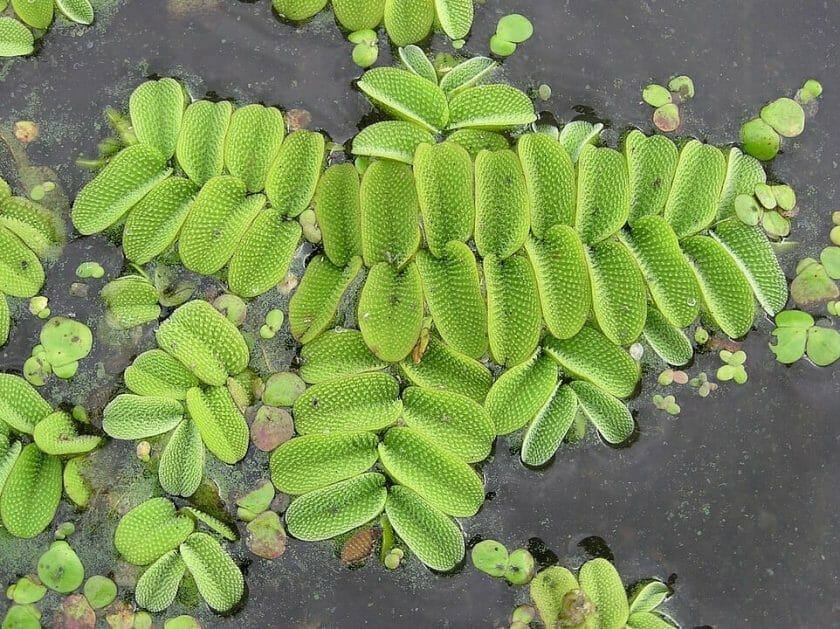
Photo by Le.Loup.Gris under CC BY-SA 3.0
| PARAMETERS | VALUES |
|---|---|
| PLANT | Salvinia Natans |
| COMMON NAMES | Floating Moss, Floating Fern, Floating Watermoss, Water Butterfly Moss |
| SCIENTIFIC NAME | Salvinia Natans |
| FAMILY | Salviniaceae |
| CARE LEVEL | Easy |
| LIGHT REQUIREMENT | Moderate to High |
| GROWTH RATE | Fast |
| TEMPERATURE | 54 – 86° F |
| pH | 6-8 |
| PLACEMENT | Floating |
| MAXIMUM SIZE | 2-3 inches |
| MINIMUM TANK SIZE | 10 gallon |
Salvinia natans is also known as floating watermoss, water butterfly, floating moss and floating fern.
It is a fast growing floating plant.
This plant is very easy to care and can tolerate a wide range of water parameters.
It can tolerate temperature as low as 54 degrees Fahrenheit which makes it an ideal choice for a cold water aquarium.
This plant has hair on its leaves which prevents algae growth.
It also provides good hiding places for fry.
How much light does Salvinia natans require?
Salvinia natans does well in moderate to high lighting conditions.
So you should provide it at least 4 watts light per gallon.
You should keep the lights as close to the water surface as possible so that it can get strong lighting.
How to keep Salvinia natans in an aquarium?
Slovenia natans is a floating aquarium plant so you should just let it float on the surface of the water of your aquarium.
Substrate requirements for Salvinia natans
As salvinia natans is a floating plant, it doesn’t require any substrate.
Ideal water parameters
Salvinia natans thrives in the temperature between 54-86 degree Fahrenheit.
Its pH tolerance range is between 6 to 8.
Fertilization requirements for Salvinia natans
Salvinia natans can do well without any fertilizers.
But as with all the aquarium plants, you can supplement it with some liquid fertilizers and it will benefit from it.
Where to buy Salvinia natans?
Check price on Amazon here
Red Root Floater

Photo by Agnieszka Kwiecień, Nova under CC BY-SA 4.0
| PARAMETERS | VALUES |
|---|---|
| PLANT | Red Root Floater |
| COMMON NAMES | Red Root Floater |
| SCIENTIFIC NAME | Phyllanthus fluitans |
| FAMILY | Phyllanthaceae |
| CARE LEVEL | Easy |
| LIGHT REQUIREMENT | Low to High |
| GROWTH RATE | Fast |
| TEMPERATURE | 70° – 82° F |
| pH | 6.5 – 7.5 |
| PLACEMENT | Floating |
| MINIMUM TANK SIZE | 10 gallon |
Red root floater is a fast growing floating aquarium plant.
This plant is very easy to care for which makes it ideal for beginners.
It can tolerate temperature as low as 70 degrees Fahrenheit so it can survive in a cold water aquarium.
Ideally, you should keep this plant in open-top tanks because it cannot tolerate too much humidity or moisture.
Too much humidity or moisture can rot this plant.
Check out more fast-growing aquarium plants.
How much light does Red root floater require?
Red root floater is very undemanding when it comes to light.
It can do well in low to high lighting conditions.
To get its red coloration, you should keep it under highlighting condition.
How to keep a red root floater in an aquarium?
Red root floater, as the name suggests, is a floating aquarium plant so you should just let it float on the surface of the water of your aquarium.
Substrate requirements
As Red root floater is a floating aquarium plant, it doesn’t require any substrate.
Ideal water parameters
The ideal temperature for the proper growth of Red root floater is between 70-82 degrees Fahrenheit.
Its pH tolerance range is between 6.5 to 7.5 and its water hardness tolerance range is between 3 to 20° D.
Fertilization requirements
Red root floater can do well without any fertilizers.
But it will benefit from some supplementation like some liquid fertilizers and CO2.
Where to buy Red Root Floater?
Check price on Amazon here
Subwassertang

Photo by Rǫgn under CC BY-SA 4.0
| PARAMETERS | VALUES |
|---|---|
| PLANT | Subwassertang |
| COMMON NAMES | Süsswassertang, Süßwassertang, Round Pellia, False Round Pellia |
| SCIENTIFIC NAME | Süsswassertang |
| FAMILY | Lomariopsidaceae |
| CARE LEVEL | Easy |
| LIGHT REQUIREMENT | Low to moderate |
| GROWTH RATE | Slow |
| TEMPERATURE | 68-73° F |
| pH | 6-8 |
| HARDNESS | 0 – 21°dKH |
| PLACEMENT | Floating |
| MINIMUM TANK SIZE | 5 gallon |
Subwassertang is a dense plant like Java moss.
This plant is very easy to care which makes it ideal for beginners.
This plant can work as a very good water purifier for your aquarium as it removes harmful toxins and heavy metals from the water.
It also oxygenates the water.
It can tolerate temperature as low as 68 degrees Fahrenheit so you can keep it in a cold water aquarium.
This plant is also good for Shrimps as it provides hiding places and feeding ground for the baby shrimps.
How much light does Subwassertang require?
Subwassertang can do well in low to moderate lighting conditions.
So you should provide it anywhere between 2-4 watts light per gallon.
How to keep Subwassertang in an aquarium?
You should attach Subwassertang to any ornament in your tank like driftwood or rock and then put inside your aquarium.
You can also just let it float in your aquarium and it will find its place.
Substrate requirements
Subway surfer tank doesn’t have true roots.
So it doesn’t really require any substrate to grow.
As with anything in your aquarium, it can also get attached to the substrate of your aquarium.
Ideal water parameters
The ideal temperature for the proper growth of Subwassertang is between 68-73 degrees Fahrenheit.
Its pH tolerance range is between 6 to 8 and you should keep it in the soft water.
Fertilization requirements
Subwassertang can do well without any fertilizers.
But you can supplement it with some liquid fertilizers for its fast growth.
Water lettuce
See more images at Amazon here
| PARAMETERS | VALUES |
|---|---|
| PLANT | Water Lettuce |
| SCIENTIFIC NAME | Pistia |
| FAMILY | Araceae |
| CARE LEVEL | Moderate |
| LIGHT REQUIREMENT | Moderate |
| GROWTH RATE | Moderate |
| TEMPERATURE | 70 to 80 °F |
| pH | 6.5-7.2 pH |
| HARDNESS | Soft to Moderately Hard |
| PLACEMENT | Water Surface |
| MAXIMUM SIZE | 10 inches |
| MINIMUM TANK SIZE | 10 gallon |
Water lettuce is a very unique-looking floating aquarium plant that you can keep in your cold water aquarium.
This aquarium plant is not very popular in the aquarium hobby because it is actually illegal in some states and countries, so you will need to check the regulations in your state or country before you buy it for your aquarium.
Besides that, it is also very challenging to grow Water lettuce in a home aquarium because it requires specific humid conditions to grow properly.
How much light does water lettuce need
Water lettuce grows in low to moderate lighting environment.
Mostly, the water lettuce that you would get for your aquarium would be grown in a shade.
So you will need to make sure to match similar lighting conditions, at least initially, when you get it for your aquarium.
You can use any regular full-spectrum T5 or T8 bulbs to grow these plants in your aquarium.
Where to put water lettuce in an aquarium?
Water lettuce is a floating plant so you should just keep it floating on the surface of your aquarium water
Ideal water parameters for water lettuce
Water lettuce needs temperature of around 70 degrees Fahrenheit, and the ideal pH range for this plant is between 6.5 to 7.2 and it prefers soft to moderately hard water.
Fertilization requirements for water lettuce
Water lettuce doesn’t have any particular fertilization requirements.
You just need to provide it with sufficient lighting.
Where to buy water lettuce?
Check price on Amazon here
Best low light coldwater aquarium plants
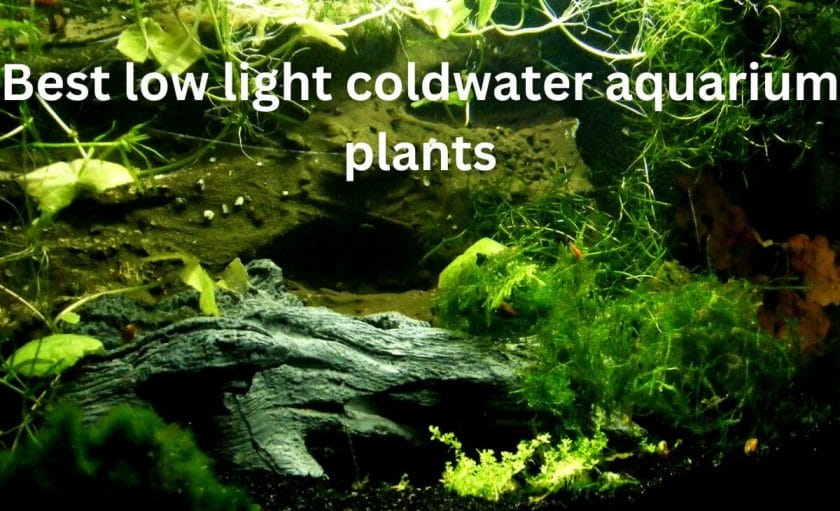
Now we’ll see the best aquarium plants that can grow in a low light environment in your coldwater aquarium.
Ludwigia Repens

| PARAMETERS | VALUES |
|---|---|
| PLANT | Ludwigia Repens |
| COMMON NAMES | Ludwigia repens, Ludwigia repens Rubin, Red repens, Ludwigia sp. Weinrot, Red-Leaf Ludwigia, Creeping Primrose-Willow |
| SCIENTIFIC NAME | Ludwigia repens |
| FAMILY | Onagraceae |
| CARE LEVEL | Easy |
| LIGHT REQUIREMENT | Low to very high |
| GROWTH RATE | Moderate to Fast |
| TEMPERATURE | 60- 86oF |
| pH | 5 – 8 |
| HARDNESS | Very soft to hard level |
| PLACEMENT | Background |
| MAXIMUM SIZE | 7-19 inches |
| MINIMUM TANK SIZE | 10 gallon |
Ludwigia repens is a very popular coloring plant in the aquarium hobby.
Its leaf color range from green, brown to deep red.
If you provided it with an ideal environment and nutrition, it can grow very fast.
It is also very easy to care and can tolerate a wide range of water parameters which makes it ideal for beginners.
This plant can tolerate temperature as low as 60 degrees Fahrenheit which makes it an ideal plant for a cold water aquarium.
How much light does Ludwigia repens require?
Ludwigia repens can do well under moderate to high lighting conditions.
You should provide it anywhere between two 2 to 4 watts light per gallon.
How to keep Ludwigia repens in an aquarium?
You can plant Ludwigia repens in the background of your aquarium.
Also, some people just let it float in their aquarium and it provides a lot of hiding places to small fish like Tetras.
Substrate requirements
You can use any substrate for Ludwigia repens and it will do just fine.
Ideal water parameters
Ludwigia repens can tolerate a wide range of water parameters.
It can tolerate temperature as low as 60 degrees Fahrenheit to up to 86 degrees Fahrenheit.
Its pH tolerance range is between 5-8 and you can keep it in very soft to very hard water.
Fertilization requirements
Ludwigia repens is a very hardy plant and can do well without any fertilizers.
But to get its red coloration, you should supplement it with some additional CO2 fertilizers.
Where to buy Ludwigia repens?
Check the latest price of this plant at Amazon here
CO2 will also help to grow it faster.
Bacopa caroliniana
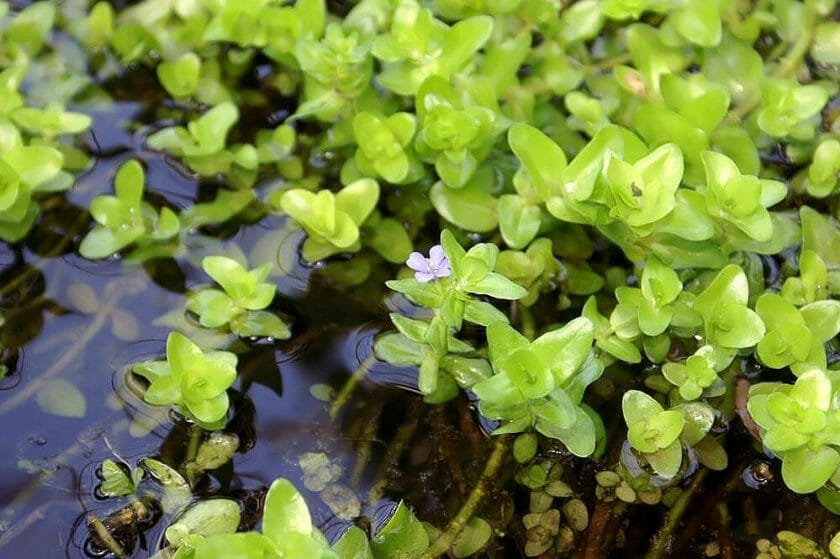
Photo by David J. Stang under CC BY-SA 4.0
| PARAMETERS | VALUES |
|---|---|
| PLANT | Bacopa |
| SCIENTIFIC NAME | Bacopa Caroliniana |
| FAMILY | Scrophulariaceae |
| CARE LEVEL | Easy |
| LIGHT REQUIREMENT | Low |
| GROWTH RATE | Slow |
| TEMPERATURE | 69.8 – 80.6°F |
| pH | 6.8 – 7.2 |
| HARDNESS | 71.43 – 142.86 PPM |
| PLACEMENT | Background |
| MAXIMUM SIZE | 11+ inches |
| MINIMUM TANK SIZE | 10 gallons |
Bacopa caroliniana is a tall stem plant.
It is commonly used in aquariums as well as in the outdoor ponds.
This plant is also very popular in aquascaping because of its pinkish-red coloration.
This plant is very undemanding which makes it ideal for beginners.
It can tolerate temperature as low as 69 degrees Fahrenheit so you can keep it in a cold water aquarium.
How much light does Bacopa require?
As mentioned earlier, Bacopa is a very undemanding plant.
It can survive in almost any lighting condition.
So, you can keep it under low to high light and it will do just fine.
How to keep Bacopa in an aquarium?
Bacopa caroliniana is a tall stem plant that can grow more than 11 inches so you should keep it in the background of your aquarium.
Substrate requirements
The ideal substrate for Bacopa caroliniana is fine gravel.
Ideal water parameters
The ideal temperature for the proper growth of Bacopa caroliniana is between 69 to 80 degrees Fahrenheit.
Its pH tolerance range is between 6.8 to 7.2 and its water hardness tolerance range is between 4 to 8° N.
Fertilization requirements
Bacopa caroliniana can do well without any fertilizers.
But to get its pinkish-red coloration, you should supplement it with additional CO2 and fertilizers.
The fertilizers will also help it to grow faster.
Where to buy Bacopa?
Check the latest price of this plant at Amazon here
Java Moss
See more images at Amazon here
| PARAMETERS | VALUES |
|---|---|
| PLANT | Java moss |
| SCIENTIFIC NAME | Vesicularia dubyana |
| FAMILY | Hypnaceae |
| CARE LEVEL | Very easy |
| LIGHT REQUIREMENT | Low to Bright |
| GROWTH RATE | Fast |
| TEMPERATURE | 59-86°F |
| pH | 5.0 to 8.0 |
| HARDNESS | 60- 240 ppm |
| PLACEMENT | Foreground |
| MAXIMUM SIZE | 4 inches |
| MINIMUM TANK SIZE | 5 gallon |
Java moss is one of the most popular plants in the aquarium hobby.
This plant is very hardy, and its requirements are very low which makes it an ideal choice for beginners.
Besides, Java moss is also very popular among breeders because it provides hiding places and food to fish fry.
How much light does Jneedava Moss need?
Java moss is not very demanding when it comes to lighting requirements. It doesn’t need any specific lighting conditions. You can use any aquarium light in your tank, and this plant will do just fine under it.
Just make sure to keep the aquarium lights on for at least 8 hours.
How to keep Java moss in an aquarium?
There are a couple of different ways you can keep Java moss in your aquarium.
The simplest way is to just toss the Java moss in the aquarium and let it find its place and settle in the tank.
However, a more common way to keep Java moss is to use it as a carpet plant by spreading it on the substrate of your aquarium.
Or, many aquascapers commonly attach this plant to driftwood or any ornament in the fish tank using aquarium-safe glue or thread.
Ideal water parameters for Java moss
Java moss can tolerate a wide range of water temperatures. It can tolerate temperatures as low as 59 degrees Fahrenheit to up to 86 degrees Fahrenheit, which makes it an ideal plant to keep in a coldwater aquarium.
Besides, the ideal pH range for Java moss is between 5 to 8, and the water hardness tolerance range is between 60-240 ppm.
Fertilization requirements
Java moss is a very hardy plant, and it is very undemanding, so you don’t have to feed it with any fertilizers.
However, adding some fertilizer to the tank will help to grow a denser and more compact plant faster.
Where to buy Java moss?
Check price on Amazon here
Lace plant
See more images at Amazon here
| PARAMETERS | VALUES |
|---|---|
| PLANT | Lace Plant |
| COMMON NAMES | Madagascar laceleaf, lattice leaf, lace plant |
| SCIENTIFIC NAME | Aponogeton madagascariensis |
| FAMILY | Aponogetonaceae |
| CARE LEVEL | Moderate |
| LIGHT REQUIREMENT | Moderate-High |
| GROWTH RATE | Low-Moderate |
| TEMPERATURE | 72-82° F |
| pH | 6.0-7.0 |
| HARDNESS | KH 3-6 |
| PLACEMENT | Mid-ground |
| MAXIMUM SIZE | 20+ inches |
| MINIMUM TANK SIZE | 10 gallon |
Lace plant is one of the unique cold-water aquarium plants for a couple of reasons.
The first reason is that it has a net-like leaf structure.
And the second reason is that this plant blooms in aquariums quite frequently if you take good care of it.
How much light does lace plant need?
The ideal light requirement for lace plant is low to moderate.
However, if you want the plant to look its best then ideally you should provide more lighting conditions of anywhere between 3-5 Watts per gallon and you can use full spectrum bulbs.
What’s the best place to keep lace plant in the aquarium?
The best place to keep lace plant in an aquarium is mid-ground.
If you have a smaller tank, then you should keep it in the background, as this plant can grow pretty tall.
As this is a very tall growing plant so you should not keep it in a fish tank that is less than 10 gallons.
Substrate requirements for less plant
Lace plant is not very demanding when it comes to the substrate.
You can keep it in any substrate like sand or fine gravel substrate. It doesn’t need any special fertilized soil substrate.
Fertilization requirements for Lace plant
Lace plant is not very demanding when it comes to fertilization. However, if you want the plant to look its best, then you can provide it with additional CO2 and iron-rich fertilizers that also contain trace elements.
Ideal water parameters for Lace plant
Lace plant can tolerate temperatures as low as 70 degrees Fahrenheit so you can keep this plant in your cold water aquarium.
Besides that, the ideal pH range for this plant is between 6 to 7, and the water hardness tolerance range is between 3 to 6 KH.
Where to buy lace plant?
Check price on Amazon here
Best cold water aquarium plants for goldfish
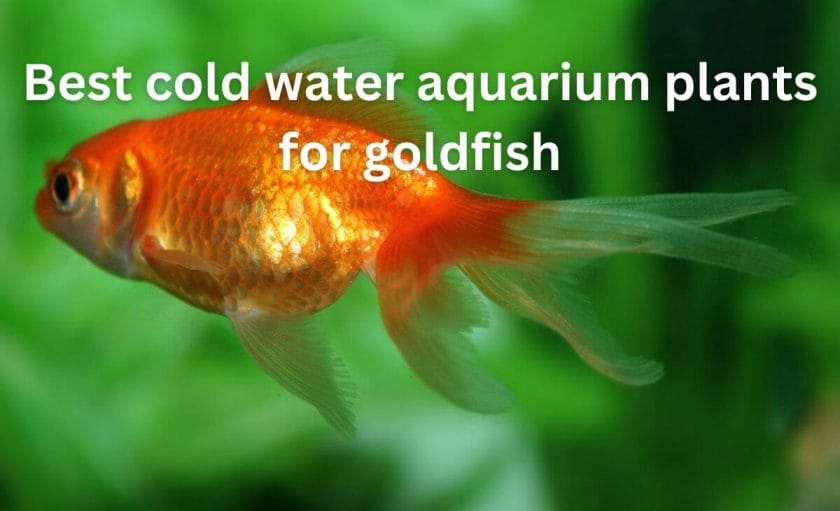
Goldfish are one of the most popular aquarium fish.
And since the ideal temperature range for goldfish is between 68 to 74 degrees Fahrenheit, if you want to keep live aquarium plants in the tank, you will need to look for plants that can tolerate fairly low water temperatures.
So in this section, I am going to tell you the best aquarium plants that you can keep in your goldfish tank that can tolerate lower water temperatures.
Java fern
See more images at Amazon here
| PARAMETERS | VALUES |
|---|---|
| PLANT | Java Fern |
| COMMON NAMES | Java Fern |
| SCIENTIFIC NAME | Microsorum pteropus |
| FAMILY | Polypodiaceae |
| CARE LEVEL | Easy |
| LIGHT REQUIREMENT | Low to Moderate |
| GROWTH RATE | Low to Moderate |
| TEMPERATURE | 68-82oF |
| pH | 6.0-7.5 |
| HARDNESS | 60-160 ppm |
| PLACEMENT | Mid to Background |
| MAXIMUM SIZE | 13.5 inches |
| MINIMUM TANK SIZE | 5 Gallons |
Java fern is one of the most popular aquarium plants in the aquarium hobby.
And the reason behind this is that this plant is very hard and has a very unique shape.
As it is a very popular plant in the aquarium hobby, it is widely available everywhere, and it is also very cheap.
Light requirements for Java fern
Java fern is not a very demanding plant when it comes to light.
It can survive in almost any lighting condition.
However, it prefers a low lighting environment.
And if you keep it under very strong light, then it will start turning brown.
So overall, you should keep Java fern in low to moderate lighting conditions.
And you should provide light anywhere between 1.5 to 2 Watts of light per gallon of your fish tank using 5000 to 7000 Kelvin bulbs.
Best place to put Java fern in your aquarium
Java fern is a tall growing plant so you should keep this plant in the middle or at the back of your fish tank.
Exactly where you should put the plant in your aquarium depends on the size of your fish tank.
If you have a fairly large aquarium, then you should put it in the middle of your fish tank, or if you have a relatively smaller aquarium, like less than 10 gallons, then you should keep it in the back of your fish tank.
Ideal water parameters for Java fern
Java fern can tolerate temperatures as low as 68 degrees Fahrenheit making it one of the best plants to keep in a cold water aquarium like a goldfish tank.
Besides, the ideal pH range for Java fern is between 6 to 7.5 and the water hardness tolerance range is between 3-8 kh.
Substate requirements for Java fern
Java fern don’t need any special fertilized soil substrate in the tank to grow.
This is because this plant doesn’t even absorb nutrients through its roots.
In fact, this plant doesn’t even have real roots. It has rhizomes instead.
These rhizomes help the plant attach itself to anything in the aquarium so that it can stay in one place.
So overall Java fern doesn’t have any specific substrate requirements. And you can plant it in any substrate of your choice whether that is sand, gravel, etc.
Fertilization requirements for Java fern
Java fern is a very hardy plant, and it doesn’t require any additional fertilization for it to grow properly in your aquarium.
However, you can speed up its growth by adding some additional fertilizer to your aquarium.
As this plant doesn’t absorb any nutrients from the substrate and instead absorbs nutrients from the water column through its leaves, you should use a liquid fertilizer that you can add to the water column of your aquarium. You don’t need to use root tabs for this aquarium plant.
Where to buy Java fern?
Check price on Amazon here
Anubias
See more images at Amazon here
| PARAMETERS | VALUES |
|---|---|
| PLANT | Anubias |
| COMMON NAMES | |
| SCIENTIFIC NAME | Anubias |
| FAMILY | Araceae |
| CARE LEVEL | Easy |
| LIGHT REQUIREMENT | Low-Moderate |
| GROWTH RATE | Slow |
| TEMPERATURE | 72-82°F |
| pH | 6.5 – 7.8 |
| HARDNESS | 60- 160 ppm |
| PLACEMENT | Mid-background |
| MAXIMUM SIZE | 11+ Inches |
| MINIMUM TANK SIZE | 5 Gallons |
| PROPAGATION | Rhizome Division |
Anubias is another very popular aquarium plant in the aquarium hobby.
This plant is fairly hardy, and it can tolerate a wide range of water parameters, which makes it an ideal choice for beginners.
Light requirements for Anubias
Anubias is not very demanding when it comes to light.
You should keep it in low to moderate lighting conditions.
And you should provide it with light anywhere between 1.8 to 3 watts per gallon.
Now, if you provide Anubias with more lighting, it may grow more quickly, but in that case, there is also a risk that it can cause algae growth on the aquarium plant.
So overall you should provide low to moderate lighting to Anubias in your aquarium.
What’s the best place to put Anubias in your aquarium?
Anubias is a short-growing plant and so you should keep it in the foreground of your aquarium.
You can bury the rhizomes of this plant in the substrate of your aquarium and keep them there.
However, a more common way to keep Anubias in an aquarium is by attaching it to a porous rock or driftwood using aquarium-safe glue.
Ideal water parameters for Anubias
Anubias can tolerate temperatures as low as 72 degrees Fahrenheit which is within the range of the temperature that goldfish need, which makes it a great plant for a goldfish aquarium.
Besides that, the ideal pH range for Anubias is between 6.5 to 7.8. And the water hardness tolerance range is between 3-8 kh.
Fertilization requirements for Anubias
Anubias is not very demanding when it comes to nutrients. However, if you can provide it with more nutrients, then it will grow much faster.
As Anubias doesn’t draw nutrients through its roots, in fact, it doesn’t actually have any real roots, instead, it has rhizomes.
If you want to provide it with some fertilization, you should add the fertilizer to the water column; in other words, you should use liquid fertilizer and not root tabs.
Where to buy Anubias?
Check price on Amazon here
Best aquarium plants for Axolotls
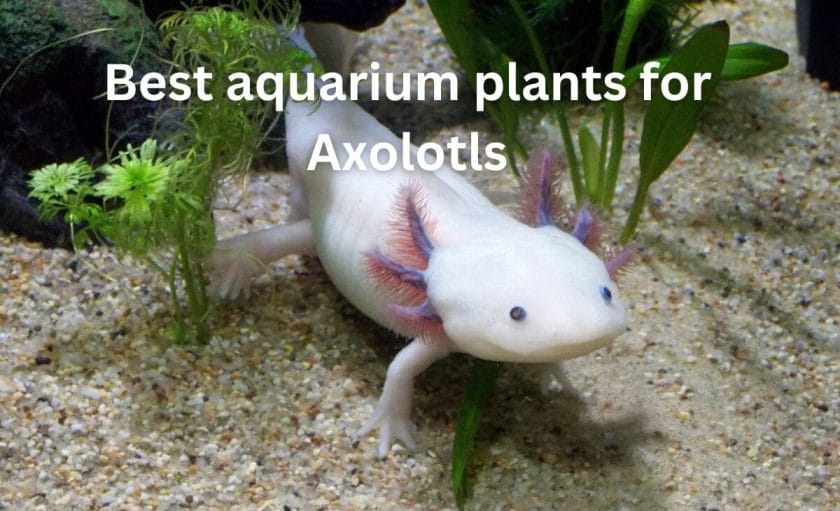
Axolotl a very unique creature that you can keep in your aquarium.
And Axolotls prefer cooler water in their aquarium that is lower than 70 degrees Fahrenheit.
So if you want to keep some live aquarium plants in your Axolotls tank then you will need to keep the plants that needs water temperature around 70 degrees Fahrenheit.
So in this section, I am going to tell you about such plants that you can keep in your Axolotls tank.
Amazon sword
See more images at Amazon here
| PARAMETERS | VALUES |
|---|---|
| PLANT | Amazon sword |
| SCIENTIFIC NAME | Echinodorus grisebachii |
| FAMILY | Alismataceae |
| CARE LEVEL | Easy |
| LIGHT REQUIREMENT | Moderate |
| GROWTH RATE | Fast |
| TEMPERATURE | 60.8-82.4°F |
| pH | 6.5-7.5 pH |
| HARDNESS | 8-15°dH |
| PLACEMENT | Background |
| MAXIMUM SIZE | 16 Inches |
| MINIMUM TANK SIZE | 10 Gallons |
Amazon sword is one of the most popular plants in the aquarium hobby.
And the reason behind that is that this plant is kind of like a centerpiece plant that you can keep in your aquarium to create a jungle effect in your tank.
And another reason is that this plant is very hardy and can tolerate a wide range of water temperatures. So you can not only keep it in a coldwater aquarium but also in a tropical aquarium!
Light requirements for Amazon sword
Amazon sword is not very demanding when it comes to light. However, it does need light for around 10 to 12 hours every day.
Generally speaking, the intensity of the light doesn’t really matter for this plant.
This plant will do just fine in low to moderate lighting conditions.
One point to consider when it comes to Amazon sword is that this plant is very prone to algae growth on its leaves. That’s why it is very important to maintain a regular lighting schedule in your aquarium to avoid any algae issues with this aquarium plant.
To follow the aquarium light schedule on a daily basis, you should use an electric timer so that the aquarium lights will turn on automatically every day at the same time and turn off automatically every day at the same time.
There are a lot of electric timers available on the market. This is the one I recommend because it is very reliable and gets the job done.
What’s the best place to keep Amazon sword in your aquarium?
Amazon sword has large leaves, and the leaves grow from all sides.
That’s why, ideally, you should keep Amazon sword in the center of your aquarium.
Or if you have a fairly large aquarium, you can keep this plan at the back of your aquarium.
Substrate requirements for Amazon sword
You don’t necessarily need a soil-based substrate for Amazon sword, and you can keep this plant in any substrate of your choice, like sand or gravel.
However, I recommend keeping Amazon sword in fine grained sand substrate.
Fertilization requirements for Amazon sword
For proper, lush, and faster growth of Amazon sword, you should supplement this plant with fertilizers.
You can use root tabs to provide it nutrients or you can also use liquid fertilizer for this plant.
Ideal water parameters for Amazon sword
Amazon sword is a very hardy plant, and it can tolerate a wide range of water parameters.
This plant can tolerate temperatures as low as 60 degrees Fahrenheit which makes it an ideal choice to keep in an Axolotl tank.
Besides, the pH tolerance range of this plant is between 6.5 to 7.5 and the water hardness tolerance range of this plant is between 8 to 15 kh.
Where to buy Amazon sword?
Check price on Amazon here
Hornwort
See more images at Amazon here
| PARAMETERS | VALUES |
|---|---|
| PLANT | Hornwort |
| SCIENTIFIC NAME | Anthocerotophyta |
| CARE LEVEL | Easy |
| LIGHT REQUIREMENT | Medium |
| GROWTH RATE | Fast |
| TEMPERATURE | 59-86°F |
| pH | 6.0-7.5 |
| HARDNESS | 5-15 dGH |
| PLACEMENT | Background |
| MAXIMUM SIZE | 10 foot |
| MINIMUM TANK SIZE | 15 gallons |
Hornwort is a tall growing plant that can tolerate a wide range of water parameters which makes it an ideal choice for any cold water aquarium and particularly for Axolotl tank.
As this plant is very hardy, it is a good choice for beginners.
Light requirements for Hornwort
The light requirements for Hornwort is moderate to high.
Basically, this plant will do okay in moderate lighting conditions. However, if you want the plant to grow faster and greener then you will need to provide it more lighting.
What’s the best place to keep Hornwort in your aquarium?
As Hornwort is a tall growing plant that can grow as tall as 10 feet you should keep it in the background of your aquarium.
Substrate requirements for Hornwort
Hornwort don’t have real roots so it doesn’t actually need any Substrate to keep in the aquarium.
However, you can plant it in the substrate of your tank by burying its stem into the substrate.
Besides, you may also keep it floating in your aquarium.
Fertilization requirements for Hornwort
Hornwort have allopathic abilities. This basically means that it can produce some chemicals in the water which will restrict other plants form from absorbing nutrients for themselves.
So if you are keeping any other plants in your aquarium and you want to keep his plant along with them then, ideally, you should add some fertilizers in your tank not for Hornwort but for the other plants. So that other plants can also get sufficient nutrients and they can grow in the aquarium.
Where to buy Hornwort?
Check price on Amazon here
Brazilian Pennywort
See more images at Amazon here
| PARAMETERS | VALUES |
|---|---|
| PLANT | Brazilian Pennywort |
| SCIENTIFIC NAME | Hydrocotyle leucocephala |
| CARE LEVEL | Easy |
| LIGHT REQUIREMENT | Moderate |
| GROWTH RATE | Fast |
| TEMPERATURE | 68 – 82°F |
| pH | 6.0 – 7.8 |
| PLACEMENT | Floating or Foreground |
| MAXIMUM SIZE | 8 inches |
| MINIMUM TANK SIZE | 10 gallon |
Brazilian pennywort is a very low demanding aquarium plant.
This plant can handle a wide range of water parameters, making it an ideal choice for a cold water Axolotl tank.
This plant grows pretty quickly, so if you are looking for a fast growing plant, then this is an ideal choice for you.
Light requirements for Brazilian Pennywort
Brazilian Pennywort can do well in any lighting condition.
However, for faster growth, you should keep it in moderate to high lighting conditions.
What’s the best place to keep Brazilian Pennywort in your aquarium?
Brazilian Pennywort doesn’t grow pretty large. It can grow a maximum of 8 inches tall.
So ideally, you should keep this plant in the foreground or mid-ground of your aquarium.
Besides, you can also keep this plant floating in your aquarium.
This is especially helpful if you are breeding fish and want to create some hiding places for the fry.
Because when you keep this plant floating in your aquarium, it creates really good hiding places for the fry.
Substrate requirements for Brazilian Pennywort
Brazilian Pennywort is not very demanding when it comes to substrate.
You can keep it in any substrate of your choice.
Fertilization requirements for Brazilian Pennywort
Brazilian Pennywort is a very undemanding plant so it doesn’t require any additional fertilization.
However, if your fish tank lacks essential nutrients, then you should consider adding some fertilizer especially iron-rich fertilizer in your aquarium for the proper growth of Brazilian Pennywort.
Besides that, if you really want this plant to grow pretty fast then you can also add additional CO2 in your aquarium.
Where to buy Brazilian Pennywort?
Check price on Amazon here
Floating Crystalwort or Riccia Fluitans
See more images at Amazon here
| PARAMETERS | VALUES |
|---|---|
| PLANT | Riccia fluitans |
| COMMON NAMES | Floating Crystalwort |
| SCIENTIFIC NAME | Riccia fluitans |
| FAMILY | Ricciaceae |
| CARE LEVEL | Easy |
| LIGHT REQUIREMENT | Moderate |
| GROWTH RATE | Moderate |
| TEMPERATURE | 56-86°F |
| pH | 6.0-8.0 |
| HARDNESS | Moderate soft to very hard water |
| PLACEMENT | Surface or foreground |
| MAXIMUM SIZE | 1.9 inches |
| MINIMUM TANK SIZE | 10 gallon |
Floating Crystalwort or Riccia Fluitans is a very unique-looking moss-like plant that you can keep in your cold water Axolotl tank.
This is a short plant that can be used as a carpet plant in your aquarium. So if you are looking for a carpeting plant for your Axolotl tank then this is a great choice for you.
Besides, this plant is also very easy to take care of so even if you are a beginner you can keep this in your tank.
Light requirements for Floating crystalwort
Floating crystalwort doesn’t require much lighting; it can do well in low to moderate lighting conditions.
What’s the best place to keep Floating crystalwort in your aquarium?
Floating crystal volt is a very short moss type plant so you can use this plant as a carpeting plant and spread it across the substrateute of your aquarium.
You can also attach this plant to any ornament like driftwood or rock in your aquarium and put it anywhere in your aquarium.
Ideal water parameters for Floating crystalwort
Floating Crystalwort can tolerate a wide range of water parameters.
It can tolerate temperature as low as 56 degrees Fahrenheit making it a great choice for any cold water aquarium, specifically for an Axolotl aquarium.
Besides that, the pH tolerance range of this plant is between 6 to 8, and the water hardness tolerance range is up to 21 dkh.
Substrate requirement for Floating crystalwort
As the name suggests, Floating crystalwort can be kept floating in the aquarium, so it doesn’t really need or have any substrate requirements.
However, you can plant it in the substrate of your tank and use it as a carpeting plant.
Fertilization requirement for Floating crystalwort
For faster and lusher growth, this plant will benefit from liquid fertilizer.
So if you want the plant to grow faster and greener, then you should ideally supplement it with some liquid fertilizer.
Where to buy Floating crystalwort?
Check price on Amazon here
Best easy live aquarium plants for cold water aquarium
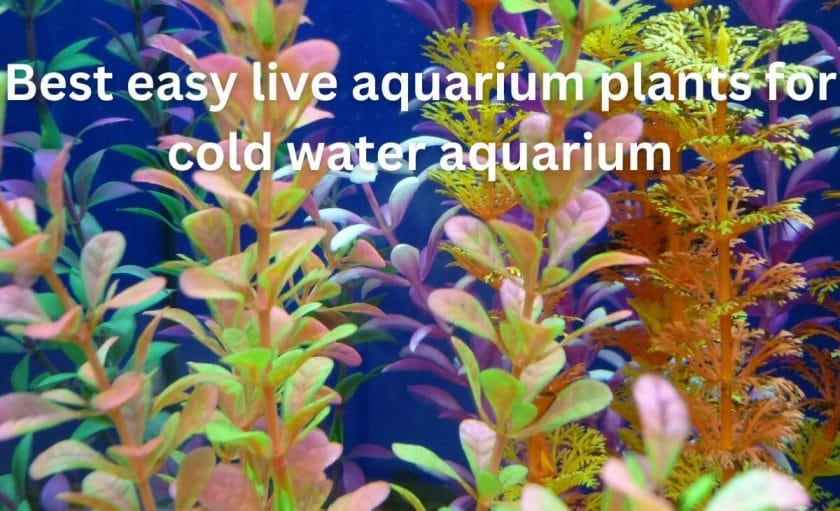
If you are a beginner and if you want to keep some live aquarium plants in your cold water tank then in this section I am going to mention a couple of very easy to care for life plants for your cold water aquarium.
Guppy Grass
| PARAMETERS | VALUES |
|---|---|
| PLANT | Guppy grass |
| COMMON NAMES | Guppy grass |
| SCIENTIFIC NAME | Najas guadalupensis |
| FAMILY | Hydrocharitaceae |
| CARE LEVEL | Easy |
| LIGHT REQUIREMENT | Moderate |
| GROWTH RATE | Fast |
| TEMPERATURE | 50-86° F |
| pH | 6-7 |
| HARDNESS | 2-25 dKH |
| PLACEMENT | Surface, background |
| MAXIMUM SIZE | 3 feet |
| MINIMUM TANK SIZE | 10 gallon |
| PROPAGATION | Side shoots/clippings |
Guppy grass is a fast growing aquarium plant.
It got its name because it is very popular among Guppy breeders as it provides a lot of hiding places for Guppy fry.
This plant is very easy to care for and can tolerate a wide range of water parameters.
It can tolerate temperature as low as 50 degrees Fahrenheit so it is a very good aquarium plant for cold water aquariums.
It is also very good water purifying plant as it removes all the harmful toxins, ammonia, nitrate and nitrite from the water and it also oxygenates the water.
Check out more oxygenating plants for aquarium.
How much light does Guppy grass require?
Guppy grass can do well under moderate lighting conditions.
You should provide it at least 3-4 watts light per gallon.
How to keep Guppy grass in an aquarium?
There are a couple of ways you can keep Guppy grass in your aquarium.
The simplest way is to just let it float in your aquarium.
Another way is to plant it in the substrate of your aquarium.
Substrate requirements
You can use any substrate for planting Guppy grass in your aquarium.
Ideal water parameters
As mentioned earlier, Guppy grass can tolerate a wide range of water parameters.
That being said, the ideal temperature for the proper growth of this plant is between 50-86 degrees Fahrenheit.
Its pH tolerance range is between 6 to 7 and the water hardness tolerance range is between 2 to 25 dKH.
Fertilization requirements
For the faster growth of Guppy grass, you should supplement it with some liquid fertilizers.
You should add liquid fertilizers after the weekly water change.
Where to buy Guppy grass?
Check the latest price of this plant at Amazon here
6 Tips to Take Care of Live Plants in Aquarium (For Beginners)
Christmas Moss
See more images at Amazon here
| PARAMETERS | VALUES |
|---|---|
| PLANT | Christmas moss |
| COMMON NAMES | Christmas moss |
| SCIENTIFIC NAME | Vesicularia montagnei |
| FAMILY | Hypnaceae |
| CARE LEVEL | Easy |
| LIGHT REQUIREMENT | Moderate to high |
| GROWTH RATE | Moderate to high |
| TEMPERATURE | 68-82°F |
| pH | 5-7.5 |
| HARDNESS | 5-20 dH |
| PLACEMENT | Floating, foreground |
| MAXIMUM SIZE | 4 inches |
| MINIMUM TANK SIZE | 5 gallon |
Christmas moss can tolerate a wide range of water parameters, and it is a very hardy plant, which makes it an ideal choice for beginners who want to keep some live plants in their cold water aquarium.
Light requirements for Christmas moss
Christmas is not very demanding when it comes to light.
It can do well in moderate lighting conditions.
However, if you want faster growth, then you should provide it with high lighting conditions.
What’s the best place to keep Christmas moss in aquarium?
There are several ways to keep Christmas moss in your aquarium, and that is why it is very popular among aquascapers.
The simplest way you can keep this plant in your aquarium is to just keep it floating in the tank.
Besides that, you can also attach it to any ornament, driftwood, or rock in your aquarium.
You can also use it as a carpet plant and spread it across the substrate of your aquarium.
Ideal water parameters for Christmas moss
Christmas moss can tolerate a fairly wide range of water parameters.
It can tolerate temperatures as low as 68-degree Fahrenheit making it one of the best plants to keep in a cold water aquarium.
Besides that, the ideal pH range for this plan is between 5 to 7.5.
Fertilization requirements for Christmas moss
You don’t need to provide any additional fertilizer to Christmas moss.
However, if you want faster and more lush green growth, then you should ideally supplement it with some liquid fertilizer.
Where to buy Chrismass moss?
Check price on Amazon here
Best fast growing aquarium plants for cold water aquarium
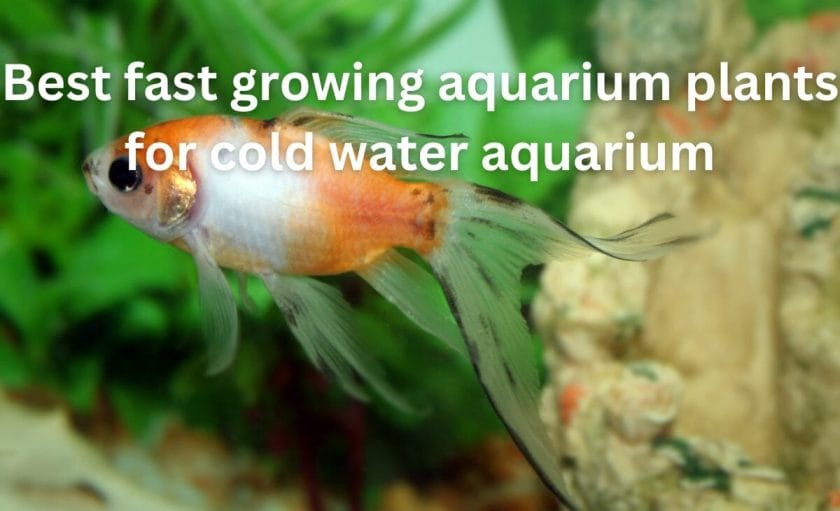
If you are looking for some fast growing aquarium plants to keep in your cold water aquarium then in this section I am going to cover such plants so you can choose any of them to put in your aquarium.
Jungle Vallisneria
See more images at Amazon here
| PARAMETERS | VALUES |
|---|---|
| PLANT | Jungle Vallisneria |
| COMMON NAMES | Jungle Val, water celery, tape grass or eelgrass |
| SCIENTIFIC NAME | Vallisneria Americana |
| FAMILY | Hydrocharitaceae |
| CARE LEVEL | Intermediate |
| LIGHT REQUIREMENT | Medium |
| GROWTH RATE | Fast |
| TEMPERATURE | 65° – 85° F |
| pH | 6.8 – 8.0 |
| HARDNESS | Moderately Hard to Very Hard |
| PLACEMENT | Background |
| MAXIMUM SIZE | 6 feet (2 meters) |
| MINIMUM TANK SIZE | 10 gallon |
Jungle Vallisneria is considered one of the first aquarium plants introduced in the hobby.
This plant is very hardy, and it can tolerate a wide range of water parameters. And this plant can grow pretty large and pretty fast.
Light requirements for Jungle Vallisneria
Jungle Vallisneria can do well in moderate lighting conditions.
However, if you want faster growth then you should provide it with high-lighting conditions.
What’s the best place to keep Jungle Vallisneria in your aquarium?
Jungle Vallisneria is a tall growing plant that can grow as tall and 6 feet so you should keep it in the background of your aquarium.
Ideal water parameters for Jungle Vallisneria
Jungle Vallisneria can tolerate a wide range of water parameters.
It can tolerate temperatures as low as 65 degrees Fahrenheit to up to 85 degrees Fahrenheit.
Besides, its pH tolerance range is between 6.8 to 8.
And it prefers moderately hard to very hard water.
Substrate requirements for Jungle Vallisneria
Jungle Vallisneria is not very demanding when it comes to substrate.
So it doesn’t require any soil-based substate for its proper growth and development. And you can use any substance of your choice like sand or gravel for this plant.
Fertilization requirement for Jungle Vallisneria
Jungle Vallisneria is not a very demanding plant. However, for its proper growth and development, you should ideally supplement it with iron-rich fertilizer.
And you should use liquid-based fertilizer for this plant.
Where to buy Jungle Vallisneria?
Check price on Amazon here
Micro sword
Check the latest price of this plant at Amazon here
| PARAMETERS | VALUES |
|---|---|
| PLANT | Micro Sword |
| SCIENTIFIC NAME | Lilaeopsis brasiliensis |
| FAMILY | Apiaceae |
| CARE LEVEL | Moderate |
| LIGHT REQUIREMENT | High |
| GROWTH RATE | Fast |
| TEMPERATURE | 70 to 83°F |
| pH | 6.8-7.5 |
| PLACEMENT | Foreground |
| MAXIMUM SIZE | 3 Inches |
| MINIMUM TANK SIZE | 10 gallon |
Micro sword is a short-stem aquarium plant.
Under ideal conditions, this plant can go pretty fast.
However, this plant is a little difficult to maintain. So you should only keep this plant in your tank if you have some experience with live aquarium plants.
Light requirements for Micro sword
One of the reasons Micro sword is a little difficult to maintain in an aquarium is due to its lighting requirements.
This plant requires a moderate to high lighting environment.
And you should be providing it with at least three watts of light per gallon of your aquarium.
And ideally, it should be getting direct light.
What’s the best place to keep Micro sword in aquarium?
Micro sword is a short stem plant, so you should keep it in the foreground of your aquarium.
You can also use it as a carpet plant in your aquarium.
Substrate requirements for Micro sword
Micro sword is very demanding when it comes to nutrients that’s why you should ideally plant it in a nutrient rich soil based substrate.
Fertilization requirements for Micro sword
For this plant to do well in aquarium, it does require additional fertilization.
So you should provide it with fertilizers that contain nitrate, phosphate, and other micronutrients.
Where to buy Micro sword?
Check price on Amazon here
Best foreground aquarium plants for cold water aquarium
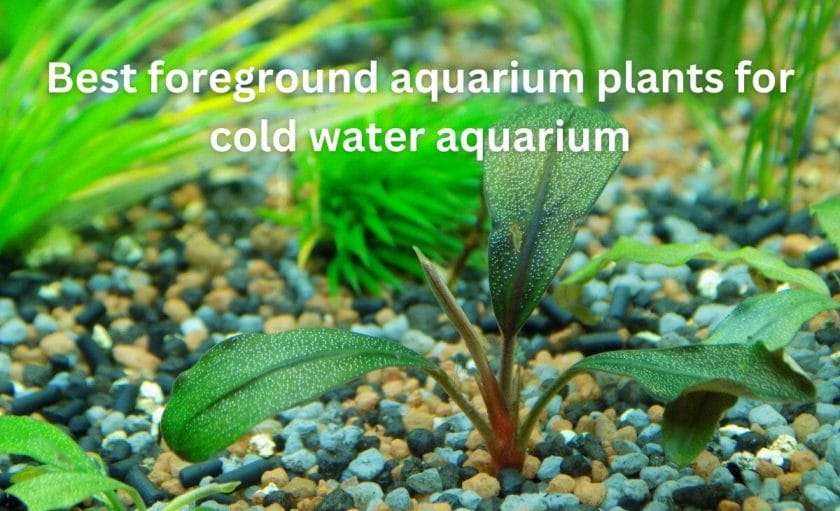
In this section, I’m going to cover the best foreground aquarium plant for your coldwatrer aquarium.
Pearlweed
See more images at Amazon here
| PARAMETERS | VALUES |
|---|---|
| PLANT | Pearl weed |
| COMMON NAMES | MICRANTHEMUM MICRANTHEMOIDES |
| SCIENTIFIC NAME | Pearl Grass and Baby Tears |
| FAMILY | Scrophulariaceae |
| CARE LEVEL | Easy |
| LIGHT REQUIREMENT | Moderate |
| GROWTH RATE | Slow |
| TEMPERATURE | 66° – 82° F |
| pH | 6.3 – 7.2 |
| HARDNESS | 4 – 18°N |
| PLACEMENT | Foreground, midground, background.,carpet |
| MAXIMUM SIZE | 6 inches |
| MINIMUM TANK SIZE | 5 gallon |
Pearlweed is one of the easiest plants that you can keep in the foreground of your cold water aquarium.
This plant is very popular among aquascapers because you can use it as a carpeting plant or attach it to any ornament in your aquarium.
Light requirements for Pearlweed
Pearlweed does well in moderate lighting conditions. So you should try to provide it light anywhere between 1.5 to 3 Watts per gallon of your aquarium water.
What’s the best place to put Pearlweed in your aquarium?
Pearlweed is a short plant and it is commonly used as a carpeting plant.
So you can use it as a carpeting plant in your aquarium or put it in the foreground of your aquarium.
Ideal water parameters for Pearlweed
Pearlweed can tolerate a fairly wide range of water parameters, especially temperature, making it a great choice for a cold water aquarium.
This plant can tolerate temperatures as low as 66 degrees Fahrenheit.
And the ideal pH tolerance range for this plant is between 6.3 to 7.2.
Substrate requirement for Pearlweed
You may plant Pearlweed in any substrate of your choice. However, for proper growth and development, ideally, you should plant it in a nutrient-rich substrate.
Fertilization requirements for Pearlweed
Pearlweed will do just fine without any additional fertilizers if your fish tank already has decent amount of nutrients.
However, for faster and more lush growth you should supplement it with some high-quality liquid-based fertilizers.
If you want the plant to look its best, then you should also consider adding some CO2 to your aquarium.
Where to buy Pearlweed?
Check price on Amazon here
Best background plant for cold water aquarium

In this section, I’m going to cover the best background plants that you can keep in your cold water aquarium.
Moneywort
See more images at Amazon here
| PARAMETERS | VALUES |
|---|---|
| PLANT | Moneywort |
| COMMON NAMES | Moneywort |
| SCIENTIFIC NAME | Bacopa Monnieri |
| FAMILY | Scropulariacase |
| CARE LEVEL | Moderate |
| LIGHT REQUIREMENT | Moderate to High |
| GROWTH RATE | Moderate |
| TEMPERATURE | 72-82° F |
| pH | 6.5-7.5 |
| HARDNESS | KH 3-8 |
| PLACEMENT | Background |
| MAXIMUM SIZE | 12+ inches |
| MINIMUM TANK SIZE | 10 gallon |
Moneywort is a tall growing plant that can grow more than 12 inches tall.
Besides, it can tolerate temperatures around 70 degrees Fahrenheit making it one of the best cold water aquarium plants to keep in the background of the tank.
Light requirements for Moneywort
Moneywort does well in moderate to high lighting conditions.
You should provide it with at least two watts of light per gallon of your aquarium.
What’s the best place to keep Moneywort in your aquarium?
Moneywort can grow pretty large. It can grow more than 12 inches tall. So ideally, should keep it in the background of your aquarium.
Ideal water parameters for Moneywort
The ideal temperature range for Moneywort is between 72 to 82 degrees Fahrenheit.
And the ideal pH range for this plant is between 6.5 to 7.5, and the ideal water hardness tolerance range for this plant is between 3-8 KH.
Substrate requirements for Moneywort
Moneywort don’t have any substrate requirements. And you can keep it in any substrate of your choice whether that is sand or gravel.
However, if you want faster and lush green growth of this plant then you should plant it in a nutrient-rich substrate.
Fertilization requirements for Moneywort
Moneywort is not a very demanding plant. However, it will benefit from some regular doses of liquid fertilizer.
So if you want faster and lusher green growth of this plant, then you should ideally supplement it regularly with some liquid fertilizer, especially after water changes.
Where to buy Moneywort?
Check price on Amazon here
What is a cold water aquarium?
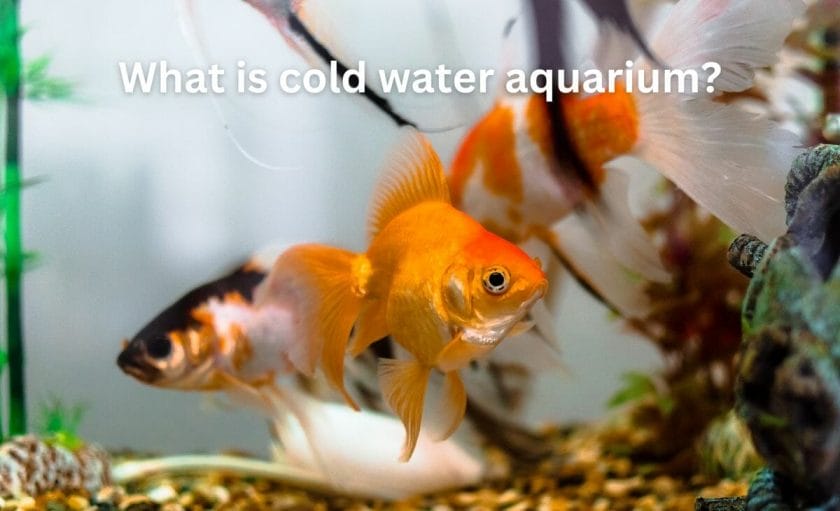
A cold water aquarium is basically an aquarium that houses cold water aquarium fish.
On average, cold water aquarium fish can tolerate temperatures between 60 to 75 degrees Fahrenheit.
However, the specific water temperature tolerance range depends on each species of fish.
There are several popular aquarium species that you can keep in a cold water tank, such as goldfish and Axolotl.
Why you should keep live plants in a cold water aquarium
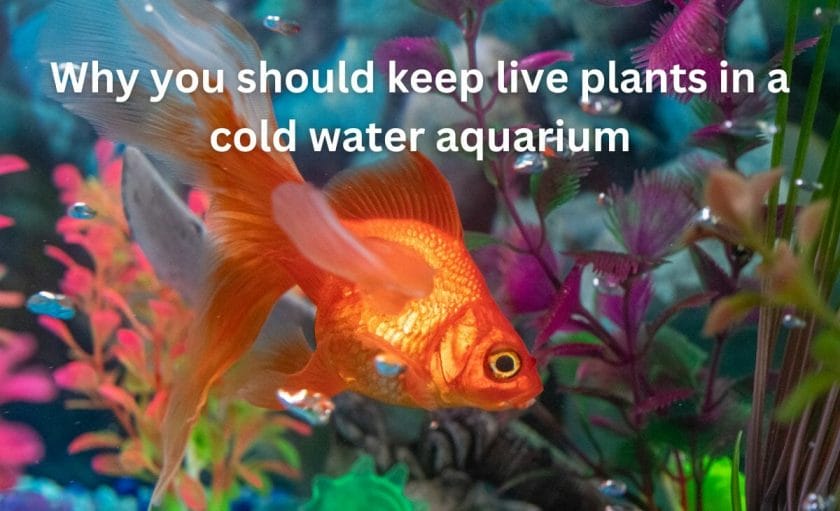
There are several benefits of keeping live aquarium plants in a cold water aquarium.
Emulating the natural habitat of fish
Fish usually have some vegetation in their natural habitat, and when it comes to keeping fish happy and healthy in your aquarium, you should try to emulate the natural habitat of your fish. And keeping some live aquarium plants in a tank is a great way to emulate the natural habitat of your fish.
Oxygen
Fish need oxygen just as we do, but they need dissolved oxygen.
And to always make sure that your fish tank has sufficient dissolved oxygen, you can add some live aquarium plants to your tank.
Reducing algae problems
Some fast growing live aquarium plants can also help keep algae out of your fish tank.
This is because algae grows when there is an abundance of nutrients.
And when you keep some live aquarium plants that are fast growing, they will absorb all the nutrients from the water which will starve algae and it will not grow in your tank.
Besides this, there are several other benefits of keeping live aquarium plants in your cold water tank.
You can read all the benefits of live aquarium plants here.
Coldwater aquarium plants buying guide
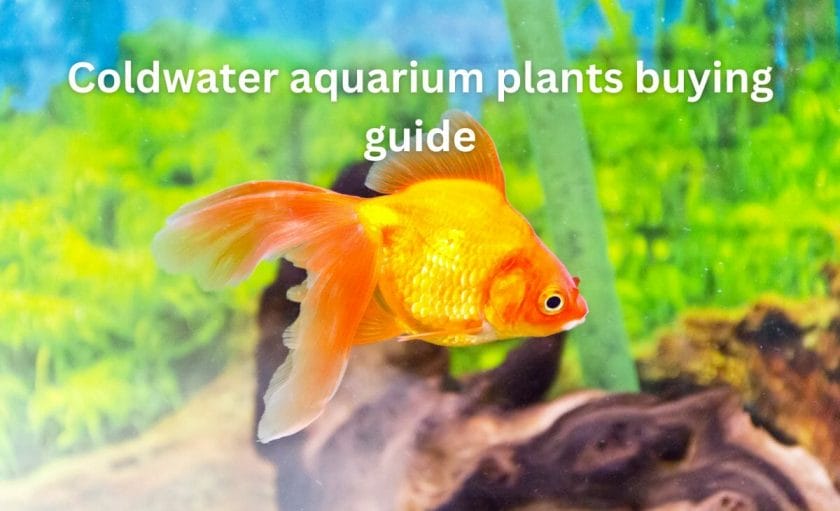
When it comes to choosing cold water aquarium plants for your cold water aquarium there are a few things that you should keep in mind before you buy the plants.
Water temperature
Generally speaking, the temperature of a cold water tank is between 60-70 degrees Fahrenheit.
However, the exact temperature of any cold water aquarium really depends on the species of fish housed in that aquarium.
So when choosing live aquarium plants for your cold water aquarium, you will need to make sure that the live aquarium plants you are purchasing need similar water temperature to the fish that your cold water aquarium contains.
Compatibility with the fish
When choosing live aquarium plants for your cold water aquarium, you will need to choose the live aquarium plants that your fish doesn’t eat.
Because there are some species of cold water fish such as goldfish that are known to eat plants in the aquarium. So in such cases, you will need to be careful while choosing the plants and you should only choose the plants that your fish will not eat.
Start with fewer plants
When you are choosing live aquarium plants for your cold water aquarium, you should not plant a lot of plants in the very beginning.
This is because this can actually lead to oxygen depletion in your fish tank at night because aquarium plants consume oxygen and release carbon dioxide at night.
So you should go slow when it comes to planting live aquarium plants in your cold water aquarium. And initially, you should choose a couple of plants to plant in your tank, and then after some time, you may add more plants to your aquarium.
What kind of animals can live in a cold water aquarium?
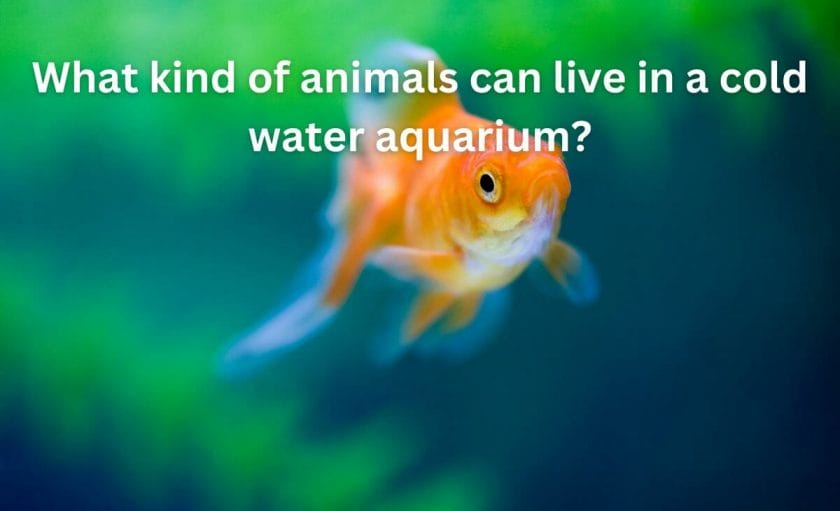
There are several different kinds of animals that can live in a cold water aquarium.
Fish
Particularly, there are several different species of fish that you can easily keep in your cold water aquarium, such as different species of Barbs such as Rosy barb, Gold barbs, Two spot barb, etc.
You can also keep different species of tetra fish in your cold water aquarium, such as blood fin Tetra and Buenos Aires tetra.
Besides one of the most popular fish, goldfish, is a cold water aquarium fish.
Also, there are several different other popular species of fish, like Zebra Danio and White cloud mountain minnow that you can keep in a cold water aquarium.
Loaches
You can also keep different types of loaches in a cold water aquarium such as hillstream loach and weather l.
Axolotl
You can also keep Axolotls in a cold water aquarium.
Shrimp
You can also keep some shrimps like cherry shrimp in a cold water aquarium as well.
Snails
Also, you can also keep snails in your cold water aquarium.
FAQ
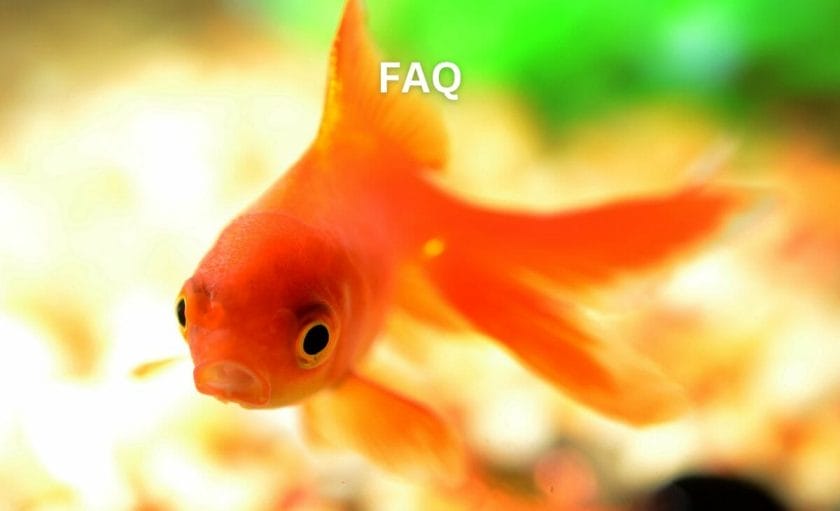
Can aquarium plants survive in cold water?
There are several aquarium plants that can survive in cold water. Some popular aquarium plants include Java moss, Java fern, Anubias, Amazon sword, etc.
Whether an aquarium plant can survive in cold water or not really depends on its temperature tolerance range.
Can Anubias grow in cold water?
Anubias can grow in cold water, as it can tolerate temperatures as low as 72 degrees Fahrenheit.
And the maximum water temperature tolerance range of Anubias is between 82 degrees Fahrenheit.
For the proper growth and development of Anubias in your aquarium, you should try to maintain the temperature within this ideal range.
What can you put in a cold water tank?
There are several different species of animals and plants you can put in a cold water tank.
For example, there are several popular aquarium fish species that you can keep in your cold water tanks, such as goldfish and barbs.
Besides, you can also keep some loaches such as dojo loaches and hillstream loach in your cold water aquarium.
You can also keep some popular types of shrimps like cherry shrimp in your cold water aquarium.
Also, you can have an Axolotl in your cold water tank.
Besides that, there are several species of live aquarium plants you can keep in a cold water aquarium such as Java fern, Java moss, Anubias, and Amazon sword.
Can Java moss survive in cold water?
Java moss can easily survive in cold water as the minimum water temperature that Java moss can tolerate is 59 degrees Fahrenheit.
The maximum water temperature range that Java moss can tolerate is about 86 degrees Fahrenheit.
So, for proper growth and development of Java moss in your aquarium, you should try to keep the temperature of the water of your aquarium within this ideal range.
How cold is too cold for aquarium?
General speaking, the ideal water temperature range for a cold water aquarium is between 60-75 degrees Fahrenheit
However, how cold is too cold for your aquarium really depends on the minimum water temperature tolerance range of the fish you are keeping in your tank.
How cold can anubias survive?
The minimum water temperature that Anubias plant can survive is 72 degrees Fahrenheit.
So ideally, you should try to keep the temperature of your tank above 72 degrees Fahrenheit if your keeping Anubias in your tank.
And the ideal water temperature tolerance range for Anubias is between 72 to 82 degrees Fahrenheit.
What temperature does Java fern need?
The ideal temperature range for Java fern is between 68 to 82 degrees Fahrenheit.
So, for the proper growth and development of Java fern in your aquarium, you should try to keep the temperature of the water in your aquarium within this ideal range.
Can moss ball survive in cold water?
Moss balls can survive in cold water as Java moss can tolerate temperature as low as 59 degrees Fahrenheit.
What’s the ideal temperature of a coldwater aquarium?
Generally, the ideal temperature for a cold water aquarium is between 60 to 75 degrees Fahrenheit.
It really depends on the species of the fish in your aquarium.
Can aquarium plants live in cold water?
Yes, there are some aquarium plants that can tolerate low temperatures.
So, you can keep them in a cold water aquarium.
All the plants that I have mentioned above can be kept in a cold water aquarium.
Do fish like plants in their tank?
Yes, most of the fish like plants in their tank.
Plants are a great way to emulate the natural habitat of fish.
Also, plants has a lot of other benefits like:
- it helps to oxygenate the tank water
- it helps to reduce ammonia in the tank
- And it also helps to lower the temperature in the aquarium, etc.
What plants are good for Axolotls?
You can keep the following plants in your Axolotls aquarium:
- Java fern
- Anubias
- Java moss
- Raccia
Can I grow aquarium plants in gravel?
Yes, there are certain species of plants you can plant in gravel.
Usually, these plants get nutrients through their leaves.
The plants that can grow in gravel include following
- Amazon sword
- Java fern
- Anubias
What temperature do aquarium plants like?
Generally, most plants can do well in temperature between 60 to 70 degrees Fahrenheit.
But it really depends on the species of the plant.
Some plants can do well even below 60 degrees Fahrenheit and others can do well above 70 degrees Fahrenheit.
What are the fast growing aquarium plants?
There are a lot of fast growing aquarium plants.
They are as follows:
- Amazon sword
- Dwarf Sagittaria
- Hornwort
- Amazon frogbit
- Java moss
- Water wisteria
- Marsilea hirsuta
- Micro sword
- Brazilian pennywort
- Giant hygro
- Duckweed
- Anacharis
- Green foxtail
I have written in detail about all of them in this blog post.
Conclusion
So, these are the best coldwater aquarium plants.
I hope you found this list helpful.
If you do, please share it.
If you have any doubts let me know in the comment section below and I will be happy to help you out.
Also, let me know which plant you are going to keep in your aquarium.
Happy fishkeeping!













